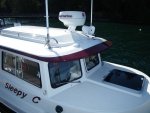I just spent a while at Home Depot looking for "plastic plumbing parts" that might do what I need. Not sure how to put it all together yet, but still looking.
I am still wondering about using a post type, with a "plus sign (+)" cross section, with some forward rake, and obviously a base plate to match what has been there already, and the top plate to fit the RayMarine radome.
The reason for the plus sign as opposed to the standard type tube is to possibly increase the radar return from the flat surfaces. (Taken from the popular round or square 3 plane reflectors). I'm thinking this may help enhance my radar visibility.
I'd like to hear any thoughts on that possibility.
Harvey
SleepyC :moon
I am still wondering about using a post type, with a "plus sign (+)" cross section, with some forward rake, and obviously a base plate to match what has been there already, and the top plate to fit the RayMarine radome.
The reason for the plus sign as opposed to the standard type tube is to possibly increase the radar return from the flat surfaces. (Taken from the popular round or square 3 plane reflectors). I'm thinking this may help enhance my radar visibility.
I'd like to hear any thoughts on that possibility.
Harvey
SleepyC :moon

